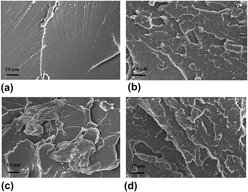Crossref Citations
This article has been cited by the following publications. This list is generated based on data provided by
Crossref.
Basha, Ahmad Fouad
and
Basha, Mohammad Ahmad-Fouad
2017.
Impact of neutron irradiation on the structural and optical properties of PVP/gelatin blends doped with dysprosium (III) chloride.
Journal of Applied Physics,
Vol. 122,
Issue. 23,
Razgaleh, S. A.
and
Aravamudhan, Shyam
2017.
Thermal and Viscoelastic Properties of Underfill Using hexagonal Boron Nitride (hBN) Nanofiller.
International Symposium on Microelectronics,
Vol. 2017,
Issue. 1,
p.
000542.
Abbasi, Sara
and
Aravamudhan, Shyam
2017.
Thermal & viscoelastic properties of underfills using hexagonal boron nitride (hBN) nanofiller.
International Symposium on Microelectronics,
Vol. 2017,
Issue. 1,
p.
000542.
Özdemir, Tonguç
and
Yılmaz, Seda Nur
2018.
Hexagonal boron nitride and polydimethylsiloxane: A ceramic rubber composite material for neutron shielding.
Radiation Physics and Chemistry,
Vol. 152,
Issue. ,
p.
93.
Zhang, Xuan
Zhang, Xianlong
and
Guo, Shaoyun
2019.
Simple approach to developing high‐efficiency neutron shielding composites.
Polymer Engineering & Science,
Vol. 59,
Issue. s2,
Prasher, Sangeeta
and
Kumar, Mukesh
2019.
Radiation Effects in Polymeric Materials.
p.
351.
Castley, Danielle
Goodwin, Cameron
and
Liu, Jifeng
2019.
Computational and experimental comparison of boron carbide, gadolinium oxide, samarium oxide, and graphene platelets as additives for a neutron shield.
Radiation Physics and Chemistry,
Vol. 165,
Issue. ,
p.
108435.
Cataldo, Franco
and
Prata, Michele
2020.
Micro and Nanostructured Composite Materials for Neutron Shielding Applications.
p.
263.
Mangal, Utkarsh
Seo, Ji-Young
Yu, Jaehun
Kwon, Jae-Sung
and
Choi, Sung-Hwan
2020.
Incorporating Aminated Nanodiamonds to Improve the Mechanical Properties of 3D-Printed Resin-Based Biomedical Appliances.
Nanomaterials,
Vol. 10,
Issue. 5,
p.
827.
Ramdani, Noureddine
2020.
Micro and Nanostructured Composite Materials for Neutron Shielding Applications.
p.
83.
Tamayo, P.
Thomas, C.
Rico, J.
Cimentada, A.
Setién, J.
and
Polanco, J.A.
2020.
Micro and Nanostructured Composite Materials for Neutron Shielding Applications.
p.
25.
Barala, Surendra Singh
Manda, Vikram
Jodha, Ajay Singh
Meghwal, Lala Ram
C, Ajay
and
Gopalani, Deepak
2021.
Ethylene‐propylene diene monomer‐based polymer composite for attenuation of high energy radiations.
Journal of Applied Polymer Science,
Vol. 138,
Issue. 18,
Gültekin, Kürşat
Uğuz, Gediz
Topcu, Yıldıray
and
Özel, Adnan
2021.
Structural, thermal, and mechanical properties of silanized boron carbide doped epoxy nanocomposites.
Journal of Applied Polymer Science,
Vol. 138,
Issue. 42,
Blachowicz, Tomasz
and
Ehrmann, Andrea
2021.
Shielding of Cosmic Radiation by Fibrous Materials.
Fibers,
Vol. 9,
Issue. 10,
p.
60.
Geren, Necdet
Acer, Durmus Can
Uzay, Cagri
and
Bayramoglu, Melih
2021.
The effect of boron carbide additive on the low‐velocity impact properties of low‐density foam core composite sandwich structures.
Polymer Composites,
Vol. 42,
Issue. 4,
p.
2037.
Zeng, Chenhao
Kang, Qing
Duan, Zhongshan
Qin, Bing
Feng, Xiaojie
Lu, Haoyuan
and
Lin, Yuanye
2023.
Development of Polymer Composites in Radiation Shielding Applications: A Review.
Journal of Inorganic and Organometallic Polymers and Materials,
Vol. 33,
Issue. 8,
p.
2191.
Li, Yinong
Zhan, Jie
Song, Changhui
Yan, Zhongwei
Deng, Zhengtai
Liu, Feng
and
Yang, Yongqiang
2023.
Design and performance of a novel neutron shielding composite materials based on AlSi10Mg porous structure fabricated by laser powder bed fusion.
Journal of Alloys and Compounds,
Vol. 968,
Issue. ,
p.
172180.
Sürücü, Ali Murat
Subaşı, Serkan
Danish, Aamar
Gencel, Osman
Subaşı, Azime
and
Ozbakkaloglu, Togay
2023.
Mechanical and radiation shielding properties of SWCNT reinforced polymer/glass fiber fabric‐based nanocomposite containing different filler materials: A comparative study.
Journal of Applied Polymer Science,
Vol. 140,
Issue. 7,
Lebedev, M. P.
and
Startsev, O. V.
2023.
Radiation Aging of Polymer Composite Materials.
Polymer Science, Series D,
Vol. 16,
Issue. 2,
p.
251.
Wang, Kangbao
Ma, Litao
Yang, Chen
Bian, Zeyu
Zhang, Dongdong
Cui, Shuai
Wang, Mingliang
Chen, Zhe
and
Li, Xianfeng
2023.
Recent Progress in Gd-Containing Materials for Neutron Shielding Applications: A Review.
Materials,
Vol. 16,
Issue. 12,
p.
4305.




